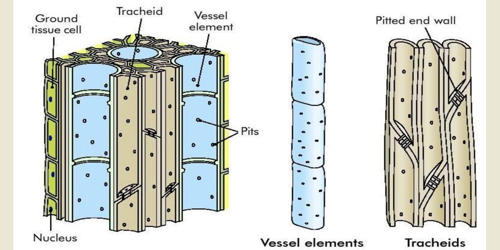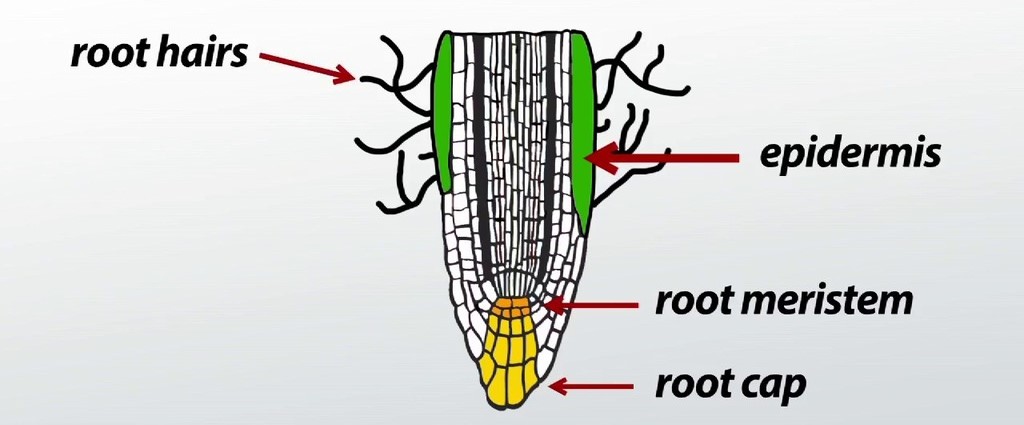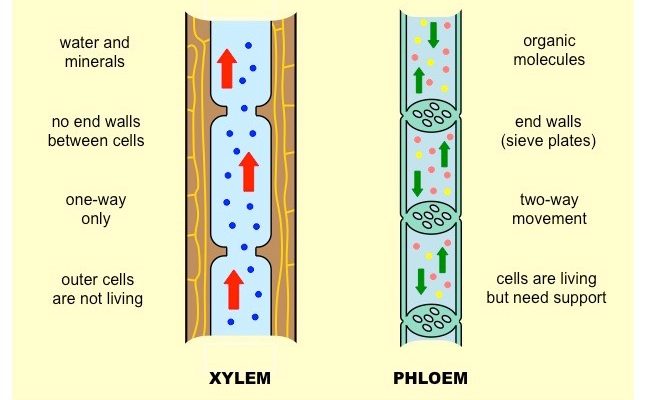Transportation in plants is the process in which substances absorbed or synthesized in one part of the plant are moved to other parts of the plant.
The Transport system in highly organised plants also known as vascular plants is responsible for moving water, nutrients, and sugars throughout the plant’s tissues. This system is essential for plant survival, growth and Reproduction. Without an efficient transport system, plants would not be able to absorb water and nutrients from the soil, produce energy through Photosynthesis or distribute nutrients to all parts of the plant.
Table of Contents
The Components of the Transport system in Highly Organised Plants
Together these components allow for the efficient movement of water, nutrients and sugars throughout the plant’s tissues.
Xylem

The Xylem is one of the two types of transport tissue found in plants, with the other being Phloem. The Xylem is responsible for transporting water and minerals from the roots of the plant to the leaves and other parts of the plant.
Definition
The Xylem is a complex tissue that is composed of several different cell types, including tracheids, vessel elements, fibres and parenchyma cells. These cells are arranged in such a way that they form a continuous network of tubes that extends throughout the plant.
Structure of Xylem
The Xylem is made up of two main types of cells: tracheids and vessel elements. Tracheids are elongated cells that are tapered at the ends and have thick, lignified walls. Vessel elements, on the other hand, are wider and shorter than tracheids and have thinner walls. They are also arranged end-to-end to form a continuous tube.
The Xylem also contains fibres, which provide structural support and parenchyma cells, which store and transport carbohydrates and other substances.
Also Check – Components of Xylem
Function of Xylem
- The primary function of the Xylem is to transport water and minerals from the roots to the leaves and other parts of the plant. This process is known as transpiration.
- Water is absorbed by the roots through root hairs and is then transported through the Xylem vessels to the rest of the plant.
- The movement of water is facilitated by the cohesion-tension theory, which states that water molecules are attracted to each other and can be pulled upward through the Xylem vessels by the transpiration pull.
- The movement of water and minerals through the Xylem is unidirectional, meaning it only flows from the roots to the rest of the plant. This is because the Xylem cells are dead and cannot actively transport water and minerals like living cells can. Instead, the movement of water and minerals through the Xylem is driven by passive physical forces, such as capillary action and adhesion, as well as the negative pressure created by transpiration.
- The Xylem also plays a role in providing structural support to the plant. The thick, lignified walls of the tracheids and vessel elements help to reinforce the Xylem and prevent it from collapsing under the pressure of the water moving through it.
Phloem

The Phloem is a specialised tissue in plants that is responsible for transporting organic compounds, such as sugars and amino acids, from the leaves to the rest of the plant. It is one of the two types of transport tissue found in plants with the other being Xylem.
Definition
The Phloem is composed of several different cell types like sieve tube elements, companion cells, fibres and parenchyma cells. These cells are arranged in such a way that they form a continuous network of tubes that extends throughout the plant.
Structure of Phloem
The Phloem is composed of two main types of cells – sieve tube elements and companion cells. Sieve tube elements are elongated cells that are arranged end-to-end to form a long, continuous tube. These cells are unique in that they lack nuclei and most other organelles, allowing for uninterrupted flow of materials through the Phloem.
Companion cells are specialised cells that are closely associated with sieve tube elements. These cells have nuclei and other organelles and they provide metabolic support to the sieve tube elements.
Phloem also contains fibres and parenchyma cells which provide structural support and store carbohydrates and other substances, respectively.
Also Check – What are the Constituents of Phloem ?
Function of Phloem
The primary function of the Phloem is to transport organic compounds, such as sugars and amino acids, from the leaves to the rest of the plant. This process is known as Translocation.
Translocation in the Phloem is driven by a pressure gradient, which is created by the active transport of sugars from source tissues (such as the leaves) into the Phloem. As the concentration of sugars in the Phloem increases, water flows into the Phloem by osmosis, creating a positive pressure gradient that pushes the sugars to other parts of the plant.
The movement of materials through the Phloem is also facilitated by specialised transport proteins, such as sucrose transporters, that actively transport sugars across cell membranes.
Also Check – 15 Difference between Xylem and Phloem
Stomata

Definition
Stomata are tiny pores found on the surface of leaves and stems in plants. They are involved in the regulation of gas exchange and water loss in plants.
Function
The main function of Stomata is to regulate the exchange of gases, such as carbon dioxide and oxygen, between the plant and the environment. During Photosynthesis Stomata opens to allow carbon dioxide to enter the plant, which is used to produce sugars and other organic compounds. Oxygen, which is produced as a byproduct of Photosynthesis, is released through the Stomata.
Stomata are also involved in the regulation of water loss in plants. When Stomata are open, water vapour is able to escape from the plant through a process called transpiration. This helps to cool the plant and maintain its temperature, but it can also lead to water loss and dehydration. To prevent excessive water loss, Stomata can close when the plant is under water stress or when the surrounding environment is dry.
Structure of Stomata
Stomata are formed by two specialized cells called guard cells. These cells are found on the surface of the leaf or stem and are able to change shape to open or close the Stomatal pore.
Guard cells are shaped like two kidney beans placed together, with a narrow opening between them called the Stomatal pore. When the guard cells are turgid (swollen with water), the Stomatal pore opens, allowing gases to enter and exit the plant. When the guard cells lose water, they become flaccid and the Stomatal pore closes.
Role in Transport System
Stomata play an important role in the transport of gases and water in plants. By regulating the exchange of gases, Stomata help to ensure that plants have the carbon dioxide and oxygen they need for Photosynthesis and respiration. By regulating transpiration, Stomata help to maintain water balance in the plant and prevent excessive water loss.
The opening and closing of Stomata is controlled by a complex interplay of signals, including environmental cues (such as light and temperature) and internal signals (such as the plant’s water status). This allows the plant to respond to changing environmental conditions and maintain its physiological balance.
Root System

Definition
Roots are a vital component of a plant’s transport system, as they anchor the plant to the ground and absorb water and nutrients from the soil. The root system of a plant consists of the roots, root hairs and other specialised cells.
Functions
The primary function of roots is to absorb water and nutrients from the soil, which are then transported up to the rest of the plant via the Xylem. Roots also anchor the plant in the ground, providing stability and support.
Roots absorb water and nutrients from the soil through the root hairs, which are tiny, finger-like projections that grow from the surface of the root. The root hairs increase the surface area of the root, allowing for more efficient absorption of water and nutrients. Water and nutrients are transported across the cell membranes of the root hairs and into the root cells, where they are transported to the rest of the plant via the Xylem.
Frequently asked Question on this topic
- What is Transportation in Plants?
- Why is the Transport System important for Plants?
- What are the components of the Transport System in highly organised Plants?
- What is Xylem and what is its function?
- What is the structure of Xylem?
- How does the Cohesion-Tension Theory explain the movement of water in Xylem?
- What is the role of Xylem in providing structural support to the Plant?
- What is Phloem and what is its function?
- What is the structure of Phloem?
- How is Translocation in the Phloem driven?
- What is the role of stomata in Plants?
- How do Stomata regulate gas exchange and water loss in Plants?
- What is the difference between Xylem and Phloem?
- What are the constituents of Phloem?
- What are some factors affecting Translocation in Plants?
Also Check – Functions of the Xylem and Phloem
Also Check – How are Water and Minerals Transported in Plants ?
Also Check – What is Translocation in Plants
Also Check – What are the Methods used by Plants to get Rid of Excretory Products


7 Comments on “What are the Components of Transport System in Highly Organised Plants”